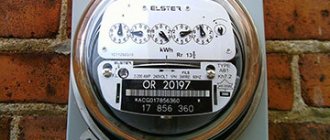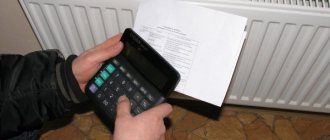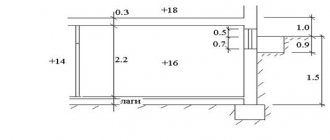In the cold season, the heating system serves as the main source of comfort in the home, and its calculation becomes especially important. Knowing the formulas and how thermal energy is measured will help organize high-quality and economical heating in a private house, and in an apartment building - calculate the heat received and stock up on weighty arguments that can be presented to the heating network. Let's understand what is hidden under the term gigacalorie, how this unit of measurement is used in calculations of different types of housing, and how to correctly calculate how much heat is used to heat a particular house or apartment.
Heating system is a source of comfort Source ultra-term.ru
What is Gcal?
We should start with a related definition.
A calorie refers to the specific amount of energy required to heat one gram of water to one degree Celsius (at atmospheric pressure, of course). And due to the fact that from the point of view of heating costs, say, at home, one calorie is a tiny amount, gigacalories (or Gcal for short), corresponding to one billion calories, are used for calculations in most cases. We've decided on this, let's move on. The use of this value is regulated by the relevant document of the Ministry of Fuel and Energy, published back in 1995.
Note! On average, the consumption standard in Russia per square meter is 0.0342 Gcal per month. Of course, this figure may vary for different regions, since everything depends on climatic conditions.
So, what is a gigacalorie if we “transform” it into values that are more familiar to us? See for yourself.
1. One gigacalorie is equal to approximately 1,162.2 kilowatt-hours.
2. One gigacalorie of energy is enough to heat a thousand tons of water to +1°C.
What is all this for?
The problem should be considered from two points of view - from the point of view of apartment buildings and private ones. Let's start with the first ones.
Apartment buildings
There is nothing complicated here: gigacalories are used in thermal calculations. And if you know how much thermal energy remains in the house, then you can present the consumer with a specific bill. Let's give a small comparison: if centralized heating operates in the absence of a meter, then you have to pay according to the area of the heated room. If there is a heat meter, this in itself implies a horizontal wiring type (either collector or serial): two risers are brought into the apartment (for “return” and supply), and the intra-apartment system (more precisely, its configuration) is determined by the residents. This kind of scheme is used in new buildings, thanks to which people regulate the consumption of thermal energy, making a choice between savings and comfort.
Let's find out how this adjustment is carried out.
1. Installation of a general thermostat on the return line. In this case, the flow rate of the working fluid is determined by the temperature inside the apartment: if it decreases, the flow rate will accordingly increase, and if it increases, it will decrease.
2. Throttling of heating radiators. Thanks to the throttle, the passage of the heating device is limited, the temperature decreases, and therefore the consumption of thermal energy is reduced.
Private houses
We continue to talk about calculating Gcal for heating. Owners of country houses are interested, first of all, in the cost of a gigacalorie of thermal energy obtained from one or another type of fuel. The table below may help with this.
Table. Comparison of cost of 1 Gcal (including transport costs)
| Name of energy resource | Approximate cost, in rubles* |
| Gas (liquefied) | 520 |
| Gas (natural) | 3 300 |
| Coal | 550 |
| Diesel fuel | 3 270 |
| Pellets | 1 800 |
| Electric Energy | 4 300 |
* - prices are approximate, since tariffs may differ depending on the region, moreover, they are constantly growing.
Option 2
Now we will calculate payments in conditions where the house is equipped with a common heating meter, and some of the apartments are also equipped with individual meters. As in the previous case, the calculation will be carried out according to two positions (thermal energy consumption for housing and ODN).
We will need formula No. 1 and No. 2 (accrual rules according to controller readings or taking into account heat consumption standards for residential premises in Gcal). Calculations will be carried out relative to the area of the residential building and apartment from the previous version.
Calculation 1
- 1.3 gigacalories – individual meter readings;
- RUR 1,1820 – approved tariff.
https://youtube.com/watch?v=dFLW96z0YVk
- Is 0.025 Gcal a standard indicator of heat consumption per 1 m2? area in the apartment;
- 70 m? – square footage of the apartment;
- 1,400 rub. – tariff for thermal energy.
Next, we calculate the second component of our payment (ODN) using two formulas - No. 13 (volume of service) and No. 10 (heating cost).
Calculation 2
- 300 gcal – readings of the common house meter;
- 12 Gcal – the amount of thermal energy used to heat non-residential premises;
- 6,000 m? – the sum of the area of all residential premises;
- 0.025 – standard (heat energy consumption for apartments);
- 9 Gcal – the sum of indicators from the meters of all apartments that are equipped with metering devices;
- 35 Gcal – the amount of heat spent on supplying hot water in the absence of a centralized supply;
- 70 m? – area of the apartment;
- 8,000 m? – total area (all residential and non-residential premises in the house).
https://youtube.com/watch?v=tGvIg-I1QCU
Please note that this option includes only the actual volumes of energy consumed and if your house is equipped with a centralized hot water supply, then the amount of heat spent on hot water supply needs is not taken into account. The same applies to non-residential premises: if they are not in the house, then they will not be included in the calculation
- 1.425 gcal – amount of heat (AT);
- 1,400 rub. – approved tariff.
As a result of the calculations, we found out that the full payment for heating will be:
- 1820 + 1995 = 3,815 rubles. - with an individual counter.
- 2,450 + 1995 = 4,445 rubles. - without an individual device.
Heat meters
Now let’s find out what information is needed in order to calculate the heating. It's easy to guess what this information is.
1. Temperature of the working fluid at the outlet/inlet of a specific section of the pipeline.
2. The flow rate of the working fluid that passes through the heating devices.
Consumption is determined through the use of heat metering devices, that is, meters. These can be of two types, let’s get acquainted with them.
Vane meters
Such devices are intended not only for heating systems, but also for hot water supply. Their only difference from those meters that are used for cold water is the material from which the impeller is made - in this case it is more resistant to elevated temperatures.
As for the mechanism of operation, it is almost the same:
- due to the circulation of the working fluid, the impeller begins to rotate;
- the rotation of the impeller is transmitted to the accounting mechanism;
- transmission is carried out without direct interaction, but with the help of a permanent magnet.
Despite the fact that the design of such meters is extremely simple, their response threshold is quite low, moreover, there is reliable protection against distortion of readings: the slightest attempts to slow down the impeller through an external magnetic field are stopped thanks to an antimagnetic screen.
Devices with a difference recorder
Such devices operate on the basis of Bernoulli's law, which states that the speed of a gas or liquid flow is inversely proportional to its static movement. But how does this hydrodynamic property apply to calculations of working fluid flow? It’s very simple - you just need to block its path with a retaining washer. In this case, the rate of pressure drop on this washer will be inversely proportional to the speed of the moving flow. And if the pressure is recorded by two sensors at once, then the flow can be easily determined, and in real time.
Note! The design of the meter implies the presence of electronics. The vast majority of such modern models provide not only dry information (temperature of the working fluid, its consumption), but also determines the actual use of thermal energy. The control module here is equipped with a port for connecting to a PC and can be configured manually.
Many readers will probably have a logical question: what to do if we are not talking about a closed heating system, but about an open one, in which selection for hot water supply is possible? How to calculate Gcal for heating in this case? The answer is quite obvious: here pressure sensors (as well as retaining washers) are installed simultaneously on both the supply and the “return”. And the difference in the flow rate of the working fluid will indicate the amount of heated water that was used for domestic needs.
We recommend reading: Korean gas boilers: review of models, characteristics, reviews
How are Gcal calculated for hot water and heating?
Heating is calculated using formulas similar to the formulas for finding the value of Gcal/h.
An approximate formula for calculating payment for warm water in residential premises:
P i gv = Vi gv * T x gv + (V v cr * Vi gv / ∑ Vi gv * T v cr)
Values used:
- P i gv – the required value;
- V i gv – volume of hot water consumption for a certain time period;
- T x gw – established tariff fee for hot water supply;
- V v gv – the volume of energy expended by the company that heats it and supplies it to residential/non-residential premises;
- ∑ V i gw – the sum of warm water consumption in all rooms of the house in which the calculation is made;
- T v gv – tariff payment for thermal energy.
This formula does not take into account the atmospheric pressure indicator, since it does not significantly affect the final desired value.
The formula is approximate and is not suitable for independent calculation without prior consultation. Before using it, you need to contact local utility services for clarification and adjustment - perhaps they use other parameters and formulas for calculation.
Calculating the size of the heating fee is very important, since often impressive amounts are not justified
The result of the calculations depends not only on the relative temperature values - it is directly influenced by the tariffs established by the government for the consumption of hot water supply and space heating.
The computational process is greatly simplified if you install a heating meter in an apartment, entrance or residential building.
It is worth considering that even the most accurate meters can allow errors in calculations. It can also be determined by the formula:
E = 100 *((V1 – V2)/(V1 + V2))
The presented formula uses the following indicators:
- E – error;
- V1 – volume of hot water supply consumed upon receipt;
- V2 – consumed hot water at the outlet;
- 100 is an auxiliary coefficient that converts the result into percentages.
In accordance with the requirements, the average error of the calculation device is about 1%, and the maximum permissible is 2%.
Video: example of calculating heating fees
Results of all calculations
In an insulated house, the number of gigacalories consumed will be less.
If you use the calculation formula correctly, you can find out the number of Gcal of thermal energy consumed. The information will help you plan your budget and clarify the final amount to be paid. Based on the above formulas, we can conclude that gigacalories are spent on a building of up to 200 square meters. This value is equal to 3 Gcal per month. Taking into account the duration of the heating season in most regions of the Russian Federation at 6 months, it is easy to determine the approximate heat consumption. You will need to multiply 3 Gcal by 6 months. The result is 18 Gcal.
It is easier to calculate the cost of gigacalories for a private home using the indicators of an individual meter. The settlement process for apartments is complicated by the presence of a house and personal meter. However, this procedure is carried out independently without visiting special organizations.
To calculate thermal energy, special mathematical formulas are used. They contain the most accurate data, and energy providers are informed about their own calculations. When making calculations, you can use online calculators or contact specialists who will perform all operations, focusing on the indicators of your premises and the type of meter.
How to convert Gcal to kW/h and Gcal/h to kW
Different metric values are indicated on different devices in the thermal power industry. Thus, kilowatt and kilowatt per hour are often indicated on heating boilers and heaters. Gcal is more often found on counting devices (meters). The difference in values prevents the correct calculation of the desired value using the formula.
To facilitate the calculation process, you need to learn how to convert one value into another and vice versa. Since the quantities have a constant value, this is not difficult - 1 Gcal/h is equal to 1162.7907 kW.
If the value is presented in megawatts, it can be converted back to Gcal/h by multiplying by a constant value of 0.85984.
Below are auxiliary tables that allow you to quickly convert values from one to another:
| Gcal | kW/h |
| 1 | 1163 |
| 2 | 2326 |
| 3 | 3489 |
| 4 | 4652 |
| 5 | 5815 |
| 10 | 11630 |
| 15 | 17445 |
| 20 | 23260 |
Reverse table to the previous one:
| kW | Gcal/h |
| 1 000 | 0,85984 |
| 5 000 | 4,29922 |
| 10 000 | 8,5984 |
| 30 000 | 25,795 |
| 50 000 | 42,992 |
| 100 000 | 85,984 |
| 500 000 | 429,9226 |
| 1 000 000 | 859,8452 |
Using these tables will greatly simplify the process of calculating the cost of thermal energy. In addition, to simplify actions, you can use one of the online converters offered on the Internet that convert physical quantities one into another.
Independent calculation of energy consumption in Gigacalories will allow the owner of residential/non-residential premises to control the cost of utilities, as well as the operation of utilities. By carrying out simple calculations, it becomes possible to compare the results with similar ones in the received payment receipts and contact the relevant authorities in case of a difference in the indicators.
Gcal and Gcal/h: what is the difference
If it is necessary to calculate the consumer's payment for state heat and power services (house heating, hot water), the value Gcal/h is used. It denotes a reference to time - how many Gigacalories are consumed during heating for a given period of time. Sometimes it is also replaced by Gcal/m3 (how much energy is needed to transfer heat to a cubic meter of water).
The value of Gcal/h can be calculated independently using this formula:
Q=V*(T1 – T2)/1000, where
- Q – amount of thermal energy;
- V – volume of liquid consumption in cubic meters/tons;
- T1 is the temperature of the incoming hot liquid, which is measured in degrees Celsius;
- T2 – temperature of the incoming cold liquid, similar to the previous indicator;
- 1000 is an auxiliary coefficient that simplifies calculations by eliminating numbers in the tenth digit (automatically converts kcal to Gcal).
This formula is often used to construct the operating principle of heat meters in private apartments, houses or enterprises. This measure is necessary when the cost of this utility service sharply increases, especially when calculations are generalized based on the area/volume of the room that is heated.
If a closed type system is installed in the room (hot liquid is poured into it once without additional water), the formula is modified:
We recommend reading: DIY installation of a heating system from polypropylene pipes
Q= (( V1* (T1 – T2)) – (V2* (T2 – T)))/ 1000, where
- Q – amount of thermal energy;
- V1 – volume of consumed thermal substance (water/gas) in the pipeline through which it enters the system;
- V2 is the volume of thermal substance in the pipeline through which it returns;
- T1 – temperature in degrees Celsius in the inlet pipeline;
- T2 – temperature in degrees Aim in the outlet pipeline;
- T – cold water temperature;
- 1000 – auxiliary coefficient.
This formula is based on the difference between the inlet and outlet values of the coolant in the room.
Depending on the use of a particular energy source, as well as the type of thermal substance (water, gas), alternative calculation formulas are also used:
- Q= (( V1* (T1 – T2)) + (V1 – V2)*( T2 – T))/1000
- Q= (( V2* (T1 – T2)) + (V1 – V2)*(T1 – T))/1000
In addition, the formula changes if electrical devices are included in the system (for example, heated floors).
Common parameters
In practice, it turns out that calculating the cost of heating is not such a simple procedure that you have to familiarize yourself with over a certain period of time. Current legislation provides for different options for making calculations depending on a number of factors, including the presence of a meter, time of year and many other parameters.
It is worth noting the fact that certain regions and local governments may establish their own rules for conducting calculations, which may supplement already adopted general legislative acts.
Thus, three main charging options can be distinguished:
- there are no devices in the house that provide heat energy metering;
- the calculation is carried out in accordance with the indicators of the heat meter installed to service a multi-storey building;
- the calculation is carried out in accordance with the indicators of the heat meter installed in each individual apartment.
General principles of calculations
How thermal energy is calculated is established by PP No. 354. The calculations are carried out by utility companies, but residents themselves are allowed to make them. Heat consumption can be determined after calculating the amount of thermal energy spent on heating per year. This period allows us to obtain an average standard, since costs are lower in summer and more in winter. Payment according to the standard provides for equal costs for the heating period or calendar year.
The calculation scheme depends on several factors:
- equipping the house with a thermal energy meter;
- the ability to account for heating of all rooms using individual devices;
- The calendar time for making payment is winter or all year.
It is more difficult to calculate thermal energy for an apartment building than for a private one. This is due to the presence of common places, residential and non-residential premises, and ownership rights. Taking into account the dependence of heat energy on the dimensions of the room, it is worthwhile to refer to PP No. 354 and PP No. 306. They indicate the distribution of the volume of heat used by the house in proportion to the area of the apartments. The readings of the general meter are divided by the proportion of housing owners.
Briefly about the main thing
The question of how thermal energy is measured arises when it is necessary to calculate a heating system. It is important to perform the calculation correctly, especially for owners of their own home. If, as a result of an error, you purchase a low-power boiler, you will waste electricity for secondary heating of your home. A boiler with an excessive power reserve will also be a mistake: operating at half the power, it will consume almost the same amount of energy resources.
A visual unit for calculating heat consumption is the gigacalorie. Consumption is calculated using different methods, which depends on the type of housing, whether it is an apartment building or a private one. Counting techniques also vary; they depend on the characteristics of the system, the availability and type of measuring devices.
What is all this for?
The problem should be considered from two points of view - from the point of view of apartment buildings and private ones. Let's start with the first ones.
Apartment buildings
There is nothing complicated here: gigacalories are used in thermal calculations. And if you know how much thermal energy remains in the house, then you can present the consumer with a specific bill. Let's give a small comparison: if centralized heating operates in the absence of a meter, then you have to pay according to the area of the heated room. If there is a heat meter, this in itself implies a horizontal wiring type (either collector or serial): two risers are brought into the apartment (for “return” and supply), and the intra-apartment system (more precisely, its configuration) is determined by the residents. This kind of scheme is used in new buildings, thanks to which people regulate the consumption of thermal energy, making a choice between savings and comfort.
Let's find out how this adjustment is carried out.
1. Installation of a general thermostat on the return line. In this case, the flow rate of the working fluid is determined by the temperature inside the apartment: if it decreases, the flow rate will accordingly increase, and if it increases, it will decrease.
2. Throttling of heating radiators. Thanks to the throttle, the passage of the heating device is limited, the temperature decreases, and therefore the consumption of thermal energy is reduced.
Private houses
We continue to talk about calculating Gcal for heating. Owners of country houses are interested, first of all, in the cost of a gigacalorie of thermal energy obtained from one or another type of fuel. The table below may help with this.
Table. Comparison of cost of 1 Gcal (including transport costs)
* - prices are approximate, since tariffs may differ depending on the region, moreover, they are constantly growing.
When is conversion from gigalories to cubic meters necessary?
Resource supply organizations indicate the gigacalories expended in heating bills .
In new buildings, building-wide and apartment-by-apartment metering of heat energy consumption has been introduced.
In older housing stock, installing heat and water supply metering devices is technically complex; in this case, the ability to convert Gcal into 1 m3 of hot water will come in handy.
Methods for calculating the amount of heat
Formula for calculating gigacalories by room area
You can determine the cost of a gigacalorie of heat depending on the availability of a metering device. Several schemes are used in the Russian Federation.
Payment without meters during the heating season
The calculation is based on the area of the apartment (living rooms + utility rooms) and is made according to the formula:
P=SхNхT, where:
- P – amount to be paid;
- S – size of the area of the apartment or house in m²;
- N – heat expended for heating 1 square in 1 month in Gcal/m²;
- T – tariff cost of 1 Gcal.
Example. The energy provider supplies heat for a one-room apartment of 36 square meters at 1.7 thousand rubles/Gcal. The consumer norm is 0.025 Gcal/m². For 1 month, heating services will be: 36x0.025x1700=1530 rubles.
Payment without meter for the whole year
Without a meter, the calculation formula P=Sx(NxK)xT also changes, where:
- N – rate of thermal energy consumption per 1 m2;
- T – cost of 1 Gcal;
- K – payment frequency coefficient (the number of heating months is divided by the number of calendar months). If the reason for the absence of an accounting device is not documented, K increases by 1.5 times.
Example. A one-room apartment has an area of 36 m2, a tariff of 1,700 rubles per Gcal and a consumer norm of 0.025 Gcal/m2. Initially, you need to calculate the periodicity coefficient for 7 months of heat supply. K=7:12=0.583. Next, the numbers are substituted into the formula 36x(0.025x0.583)x1700=892 rubles.
Cost if there is a common house meter in winter
The cost of a gigacalorie depends on the type of fuel used for a high-rise building.
This method allows you to calculate the price for central heating with a common building meter. Since thermal energy is supplied for the entire building, the calculation is based on area. The formula P=VxS/StotalxT is used, where:
- P – monthly cost of services;
- S – area of a separate living space;
- Stotal – the size of the area of all heated apartments;
- V – general readings of the collective meter for the month;
- T – tariff cost of 1 Gcal.
We recommend reading: What is a ventilation anemostat: types of diffusers and their features
Example. The square footage of the owner’s housing is 36 m2, the entire high-rise building is 5000 m2. Monthly heat consumption is 130 Gcal, the cost of 1 Gcal in the region is 1,700 rubles. Payment for one month is equal to 130 x 36 / 5000 x 1700 = 1591 rubles.
Metering devices are available in all apartments
The cost of heating services using an individual meter is 30% lower.
Depending on the presence of a collective meter at the entrance and a personal appliance in each apartment, there is a change in readings, but this does not apply to tariffs for heating services. Payment is divided between all owners according to area parameters as follows:
- Calculate the difference in heat consumption on the common house and personal meters using the formula Vdiff.=V- ∑Vroom.
- The resulting figure is substituted into the formula P=(Vroom+VрxS/Stotal)xT.
The meanings of the letters are deciphered as follows:
- P – amount to be paid;
- S – indicator of the area of a separate apartment;
- Stotal – the total area of all apartments;
- V – collective heat consumption;
- Vpom – individual heat consumption;
- Vр – difference in readings of individual and household appliances;
- T – tariff cost of 1 Gcal.
Example. In a one-room apartment of 36 m2, an individual meter was installed, which showed 0.6. On the brownie it reads 130, a separate group of devices gave 118. The square footage of a high-rise building is 5000 m2. Monthly heat costs are 130 Gcal, payment for 1 Gcal in the region is 1,700 rubles. First, the difference in readings Vр = 130 - 118 = 12 Gcal is calculated, and then a separate payment P = (0.6 + 12 x 36 / 5000) x 1700 = 1166.88 rubles.
Applying a multiplying factor
Based on PP No. 603, heating fees are charged 1.5 times more if the meter is not repaired within 2 months, or if it is stolen or damaged. An increasing factor is also established if homeowners do not transmit the readings of the device or twice do not allow specialists to check its technical condition. You can independently calculate the increasing coefficient using the formula P=Sx1.5 NxT.
Formula for calculating thermal energy (per 1 square meter)
The exact formula for calculating thermal energy for heating is taken in the ratio of 100 W per 1 square. During the calculations, it takes the form:
Q = (S × 100) × a × b× c × d × e × f × g × h × i × j × k × l × m.
Latin letters indicate correction factors:
- a is the number of walls in the room. For an internal room it is 0.8, for one external structure - 1, for two - 1.2, for three - 1.4.
- b – location of external walls along the cardinal directions. If the room faces north or east - 1.1, south or west - 1.
- c – the ratio of the room to the wind rose. House on the windward side - 1.2, on the leeward side - 1, parallel to the wind - 1.1.
- d – climatic conditions of the region. Indicated in the table.
| Temperature, degrees | Coefficient |
| From -35 | 1,5 |
| -30 to -34 | 1,3 |
| -25 to -29 | 1,2 |
| -20 to -24 | 1,1 |
| -15 to -19 | 1 |
| -10 to -14 | 0,9 |
| To 10 | 0,7 |
- e – insulation of the wall surface. For structures without insulation - 1.27, with two bricks and minimal thermal insulation - 1, good insulation - 0.85.
- f – ceiling height. Indicated in the table.
| Height, m | Coefficient |
| Up to 2.7 | 1 |
| 2,8-3 | 1,05 |
| 3,1-3,5 | 1,1 |
| 3,6-4 | 1,15 |
- g – features of floor thermal insulation. For basements and plinths - 1.4, with insulation on the ground - 1.2, if there is a heated room below - 1.
- h – features of the upper room. If there is a cold hill above - 1, an attic with insulation - 0.9, a heated room - 0.8.
- i – design features of window openings. If there is double glazing - 1.27, single-chamber double-glazed windows - 1, two-chamber or three-chamber glass with argon gas - 0.85.
- j – general parameters of the glazing area. It is calculated by the formula x = ∑Sok / Sp, where ∑Sok is the indicator common to all windows, Sp is the quadrature of the room.
- k – presence and type of entrance opening. A room without a door -1, with one door to the street or loggia - 1.3, with two doors to the street or loggia - 1.7.
- l – battery connection diagram. Listed in the table
| Inset | Peculiarities | Coefficient |
| Diagonal | Supply at the top, return at the bottom | 1 |
| One-sided | Supply at the top, return at the bottom | 1,03 |
| Double sided | Return and supply below | 1,13 |
| Diagonal | Feed below, return above | 1,25 |
| One-sided | Feed below, return above | 1,28 |
| Unilateral | Supply and return below | 1,28 |
- m – specifics of radiator installation. Indicated in the table.
| Connection type | Coefficient |
| Open on the wall | 0,9 |
| On top, hidden by a shelf or window sill | 1 |
| Closed at the top with a niche | 1,07 |
| Covered with a niche/window sill at the top and an overlay at the end | 1,12 |
| With decorative body | 1,2 |
Before using the formula, make a diagram with data for all coefficients.
Physical meaning of the heating consumption standard
Apartment buildings in the legislation of the Russian Federation, including for the purpose of calculating the volume of heat energy consumption for heating, are considered as indivisible units. That is, an apartment building is a single thermal engineering facility that consumes heat energy to heat the premises included in it. And it is the total volume of heat energy consumed by the entire house that is important when calculating the utility service provider (ICU) with the resource supply organization (RSO).
The rules for establishing and determining standards for the consumption of utility services, approved by the RF PP dated May 23, 2006 N306 (hereinafter referred to as Rules 306), in order to calculate the standard consumption of utility services for heating, first provide for the calculation of the amount of thermal energy required for heating an apartment building or residential building during the year (clause 19 of Appendix 1 to Rule 306, formula 19). The year was chosen as the period for which the calculation is made in order to further obtain the average value of the standard heat energy consumption per month, since in different calendar months the heat energy consumption for heating will, of course, be different, and payment according to the standard implies the same amount of payment for heating either within heating period, or evenly throughout the calendar year, depending on the method of payment for heating .
Since an apartment building consists of a set of residential and non-residential premises and common areas (common property), while the common property on the right of common ownership belongs to the owners of individual premises of the house, the entire volume of thermal energy entering the house is consumed by the owners of the premises of such a house. Consequently, payment for heat energy consumed for heating must be made by the owners of the apartment building premises. And here the question arises - how to distribute the cost of the entire volume of heat energy consumed by an apartment building among the owners of the premises of this apartment building?
Guided by the completely logical conclusions that the consumption of heat energy in each specific room depends on the size of such a room, the Government of the Russian Federation has established a procedure for distributing the volume of heat energy consumed by the entire house among the premises of such a house in proportion to the area of these premises. This procedure is provided for both by Rule 354 (distribution of readings from a common house heating meter in proportion to the shares of the premises of specific owners in the total area of all premises of the house owned) and Rule 306 when establishing heating consumption standards.
Paragraph 18 of Appendix 1 to Rule 306 states: “18. The consumption standard for heating utilities in residential and non-residential premises (Gcal per 1 sq.m. of the total area of all residential and non-residential premises in an apartment building or residential building per month) is determined by the following formula (formula 18):
,
where: - the amount of thermal energy consumed during one heating period by apartment buildings not equipped with collective (common building) heat energy metering devices, or residential buildings not equipped with individual thermal energy metering devices (Gcal), determined by formula 19; - the total area of all residential and non-residential premises in apartment buildings or the total area of residential buildings (sq.m); - a period equal to the duration of the heating period (the number of calendar months, including incomplete ones, in the heating period).”











